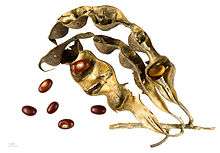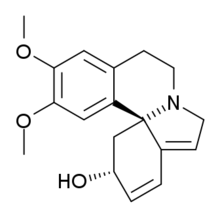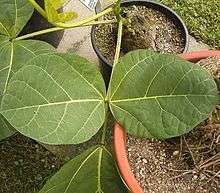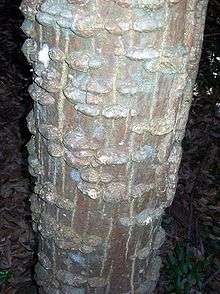Erythrina
| Coral trees | |
|---|---|
 | |
| Wiliwili (E. sandwicensis) flowers, Kanaio Beach, Maui, Hawaii | |
| Scientific classification | |
| Kingdom: | Plantae |
| (unranked): | Angiosperms |
| (unranked): | Eudicots |
| (unranked): | Rosids |
| Order: | Fabales |
| Family: | Fabaceae |
| Subfamily: | Faboideae |
| Tribe: | Phaseoleae |
| Genus: | Erythrina L. |
| Type species | |
| Erythrina corallodendron L.[1] | |
| Species | |
|
About 130, see text | |
| Synonyms | |
|
Chirocalyx Meisn. | |

Erythrina /ˌɛrᵻˈθraɪnə/[3] is a genus of flowering plants in the pea family, Fabaceae. It contains about 130 species, which are distributed in tropical and subtropical regions worldwide. They are trees, growing up to 30 m (98 ft) in height. The generic name is derived from the Greek word ερυθρóς (erythros), meaning "red," referring to the flower color of certain species.[4]
Particularly in horticulture, the name coral tree is used as a collective term for these plants. "Flame trees" is another vernacular name, but may refer to a number of unrelated plants as well. Many species of Erythrina have bright red flowers, and this may be the origin of the common name. However, the growth of the branches can resemble the shape of sea coral rather than the color of Corallium rubrum specifically, and this is an alternative source for the name. Other popular names, usually local and particular to distinct species, liken the flowers' red hues to those of a male chicken's wattles, and/or the flower shape to its leg spurs. Commonly seen Spanish names for any local species are bucaré, frejolillo or porotillo, and in Afrikaans some are called kafferboom. Mullumurikku is a widespread name in Kerala.
Description and ecology
_feeding_on_Indian_Coral_Tree_(Erythrina_variegata)_in_Kolkata_I_IMG_4005.jpg)
Not all species of Erythrina have bright red flowers; the Wiliwili (E. sandwicensis) has extraordinary variation in its flower colour, with orange, yellow, salmon, green and white all being found within natural populations. This striking color polymorphism is also found in Erythrina lysistemon and Erythrina caffra.
All species except the sterile hybrids E. × sykesii and E. × bidwillii have legume-type fruit, sometimes called pods, containing one of more seeds. The resilient buoyant seeds are often carried by the sea for large distances and are commonly called "sea beans".
Erythrina leaves are used as food plants by the larvae of some Lepidoptera species including the swift moth Endoclita damor and the woolly bears Hypercompe eridanus and Hypercompe icasia. The mite Tydeus munsteri is a pest on the coastal coral tree (E. caffra).
Many birds visit the nectar-rich Erythrina flowers. In the Neotropics, these are usually larger hummingbirds, for example the swallow-tailed hummingbird (Eupetomena macroura) and the black-throated (Anthracothorax nigricollis) and green-breasted mangos (A. prevostii) – though they seem not to be especially fond of E. speciosa at least, which they visit rather opportunistically. In Southeast Asia, the black drongo (Dicrurus macrocercus) which usually does not eat nectar in quantity has been observed feeding on E. suberosa flowers, and mynas and of course more specialized nectar feeders also utilize coral tree flowers. Lorikeets such as the collared lory (Phigys solitarius) and the possibly extinct New Caledonian lorikeet (Charmosyna diadema) are known to consume (or have consumed) large amounts of Erythrina nectar.
Use by humans
Some coral trees are used widely in the tropics and subtropics as street and park trees, especially in drier areas. In some places, such as Venezuela, bucarés are used as shade trees for coffee or cocoa crops. In the Bengal region, they are used for the same purpose in Schumannianthus dichotoma plantations. E. lanceolata in particular is considered highly suitable as "frame" tree for vanilla vines to grow up on.

The conspicuous, even dramatic coral trees are widely used as floral emblems. cockspur coral tree (E. crista-galli) is the national flower of Argentina and Uruguay. The coastal coral tree (E. caffra) is the official city tree of Los Angeles, California, where it is referred to simply as the "coral tree".[5] The state trees of Mérida and Trujillo in Venezuela are bucaré ceibo (E. poeppigiana) and purple coral tree (bucaré anauco, E. fusca), respectively. Yonabaru, Okinawa as well as the Okinawa Prefecture and Pathum Thani Province have the Indian coral tree (E. variegata) as floral emblems. Known as thong lang in Thailand, the latter species is also one of the thong ("trees") referred to in the name of Amphoe Chom Thong, Chiang Mai Province. In a similar vein, Zumpahuacán in Mexico derives its name from Nahuatl tzompahuacá, "place of the Erythrina americana". In Vietnam, people use the leaves of E. variegata to wrap nem (a kind of fermented pork).
In Hinduism, the mandara tree in Indra's garden in Svarga is held to be E. stricta. The same motif is found in Tibetan Buddhism, where the man da ra ba growing in Sukhavati is identified as an Indian coral tree (E. variegata). The concept of the Five Trees of Paradise is also found in Christian Gnosticism. Though as none of the trees is identified as an Erythrina here, the concept might not be as directly related to the Asian religions as some presume.
The seeds of at least one-third of the species contain potent erythrina alkaloids, and some of these are used for medicinal and other purposes by indigenous peoples. They are all toxic to some degree however, and the seeds of some can cause fatal poisoning. The main active compounds in this genus generally seem to be alkaloids, such as scoulerine, erysodin and erysovin (namely in E. flabelliformis), and the putative anxiolytic erythravine (isolated from Mulungu, E. mulungu). Except for ornamental purposes, growing, selling or possessing Erythrina is prohibited by Louisiana State Act 159 (where the genus is misspelled Erythina).
Selected species

- Erythrina abyssinica Lam. ex DC. (East Africa)
- Erythrina americana Mill. – Colorín,[6] Tzompāmitl[7] (Mexico)
- Erythrina ankaranensis Du Puy & Labat (Madagascar)
- Erythrina atitlanensis Krukoff & Barneby
- Erythrina berteroana Urb.
- Erythrina burana Chiov. (Ethiopia)
- Erythrina caffra Thunb. – Coastal coral tree (Southeastern Africa)
- Erythrina corallodendron L. (Hispaniola, Jamaica)
- Erythrina coralloides D.C. – Flame coral tree, naked coral tree (Arizona in the United States, Mexico)
- Erythrina crista-galli L. – Cockspur coral tree, ceibo, seíbo, bucaré (Argentina, Uruguay, Brazil, Paraguay)
- Erythrina decora Harms
- Erythrina edulis Micheli – Basul (Andes)
- Erythrina eggersii Krukoff & Moldenke – Cock's-spur, espuela de gallo, piñón espinoso (United States Virgin Islands, Puerto Rico)
- Erythrina elenae Howard & Briggs (Cuba)
- Erythrina euodiphylla Hassk. ex Backh. (Indonesia)
- Erythrina falcata Benth. – Brazilian coral tree (Brazil)
- Erythrina flabelliformis Kearney
- Erythrina fusca Lour. – Purple coral tree, bois immortelle, bucaré anauco, bucayo, gallito (Pantropical)
- Erythrina haerdii Verdc. (Tanzania)
- Erythrina hazomboay Du Puy & Labat (Madagascar)
- Erythrina herbacea L. – Coral bean, Cherokee bean, red cardinal, cardinal spear (Southeastern United States, Northeastern Mexico)
- Erythrina humeana Spreng. – Natal coral tree, dwarf coral tree, dwarf kaffirboom, dwarf erythrina (South Africa)
- Erythrina lanceolata Standl.
- Erythrina latissima E.Mey.
- Erythrina lysistemon Hutch. – Common coral tree, Transvaal kaffirboom, lucky bean tree (South Africa)
- Erythrina madagascariensis Du Puy & Labat (Madagascar)
- Erythrina megistophylla (Ecuador)
- Erythrina mexicana (Mexico)
- Erythrina mulungu Diels Mart. – Mulungu (Brazil)
- Erythrina perrieri R.Viguier (Madagascar)
- Erythrina poeppigiana (Walp.) O.F.Cook – bucare ceibo
- Erythrina polychaeta Harms (Ecuador)
- Erythrina rubrinervia Kunth
- Erythrina sacleuxii Hua (Kenya, Tanzania)
- Erythrina sandwicensis O.Deg. – Wiliwili (Hawaii)
- Erythrina schimpffii Diels (Ecuador)
- Erythrina schliebenii Harms – Lake Latumba Erythrina (Thought to be extinct since 1938, but some individuals, believed to be less than fifty, were recently rediscovered in forest remnants on rocky sites in coastal Tanzania (reported in the UK Guardian newspaper 23 March 2012, from a report in the Journal of East African Natural History.)
- Erythrina senegalensis DC.
- Erythrina speciosa Andrews (Brazil)
- Erythrina stricta Roxb. – Mandara (Southeast Asia)
- Erythrina suberosa Roxb.
- Erythrina tahitensis Nadeaud (Tahiti)
- Erythrina tholloniana
- Erythrina tuxtlana Krukoff & Barneby (Mexico)
- Erythrina variegata L. – Indian coral tree, tiger's claw, sunshine tree, roluos tree (Cambodia), deigo (Okinawa), drala (Fiji), madar (Bangladesh), man da ra ba (Tibet), thong lang (Thailand), vông nem (Vietnam)
- Erythrina velutina Willd. (Caribbean, South America, Galápagos Islands)
- Erythrina vespertilio Benth. – Bat's wing coral tree, grey corkwood, "bean tree" (Australia)
- Erythrina zeyheri Harv. – Ploughbreaker
- Erythrina ×bidwillii Lindl.
- Erythrina ×sykesii Barneby & Krukoff
Formerly placed here
- Butea monosperma (Lam.) Taub. (as E. monosperma Lam.)
- Piscidia piscipula (L.) Sarg (as E. piscipula L.)[8]
See also
References
| Wikimedia Commons has media related to Erythrina. |
| Wikispecies has information related to: Erythrina |
- ↑ "Erythrina L.". TROPICOS. Missouri Botanical Garden. Retrieved 2009-10-24.
- ↑ "Genus: Erythrina L.". Germplasm Resources Information Network. United States Department of Agriculture. 2007-04-01. Retrieved 2010-01-28.
- ↑ Sunset Western Garden Book, 1995:606–607
- ↑ Gledhill, D. (2008). The Names of Plants (4 ed.). Cambridge University Press. p. 157. ISBN 978-0-521-86645-3.
- ↑ Advisory Committee on Technology Innovation, Board on Science and Technology for International Development, Commission on International Relations, National Research Council (1979). Tropical Legumes: Resources for the Future. National Academy of Sciences. p. 258.
- ↑ "Zompantle o colorín (Erythrina americana Miller)". Tratado de Medicina Tradicional Mexicana Tomo II: Bases Teóricas, Clínica Y Terapéutica. Tlahui (20). 2005. Retrieved 2009-10-24.
- ↑ Karttunen, Frances (1992). An Analytical Dictionary of Nahuatl. University of Oklahoma Press. p. 316. ISBN 978-0-8061-2421-6.
- ↑ "GRIN Species Records of Erythrina". Germplasm Resources Information Network. United States Department of Agriculture. Retrieved 2010-10-15.
External links
- List of species of Erythrina from LegumeWeb
- Photo gallery - coral tree (Erythrina lysistemon)
- University of Florida−UF Featured Creatures: Moths of Erythrina plants — from the UF Institute of Food and Agricultural Sciences.
